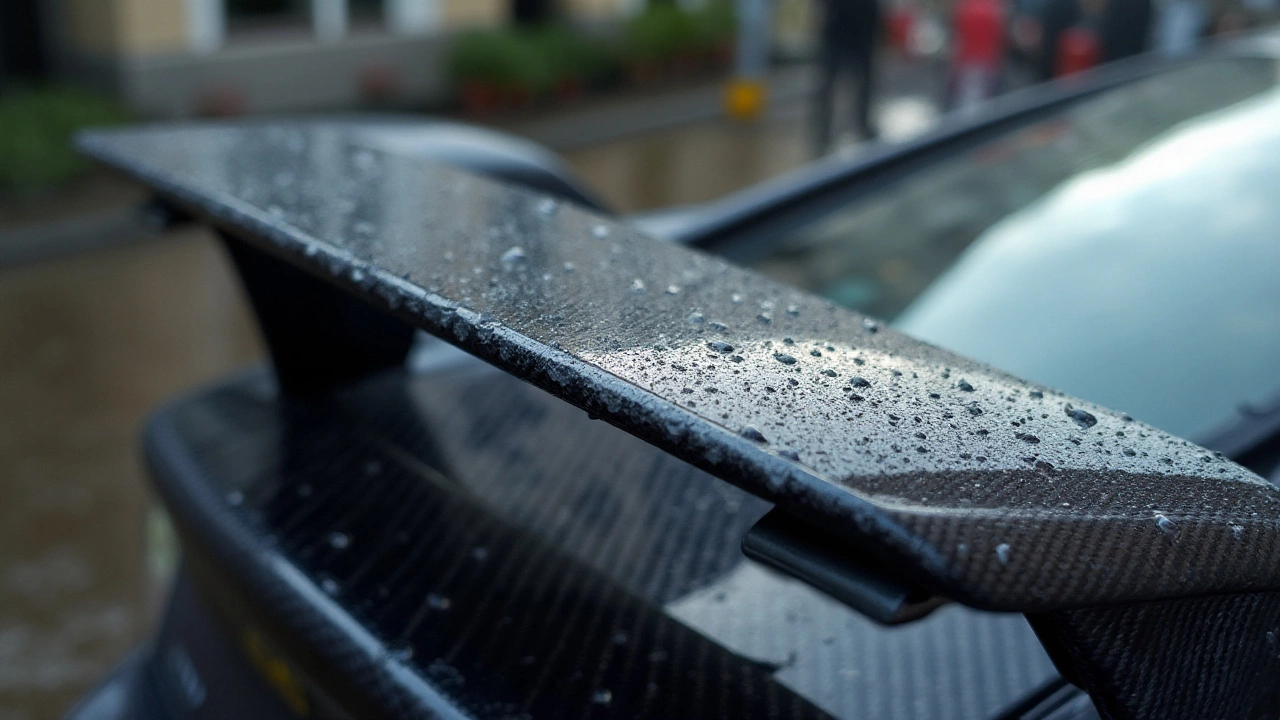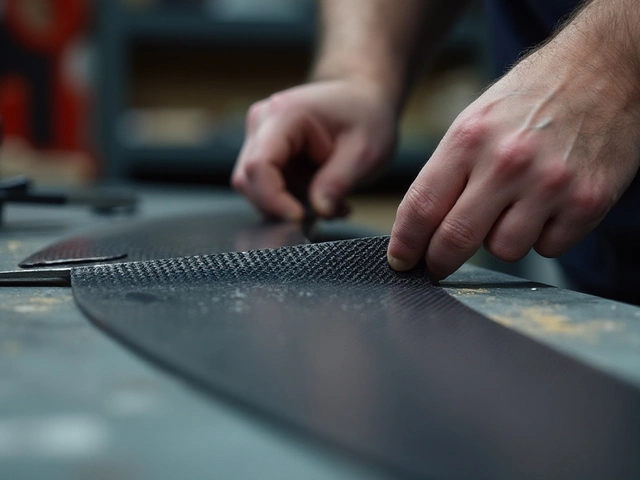In the quest for performance and aesthetics, carbon fiber has become a cornerstone material in the world of automotive engineering. Known for its lightweight properties and impressive strength-to-weight ratio, it is no surprise car enthusiasts gravitate towards carbon fiber spoilers.
However, questions often emerge regarding the durability of these components. Will they stand the test of time, or do they have a hidden tendency to weaken with age? Understanding the dynamics of carbon fiber can offer some clues. By dissecting its construction and considering external influences, we get closer to unraveling this mystery.
Through the years, carbon fiber technology has advanced, yet so have the factors that challenge its resilience. By recognizing these complexities, car owners can make informed decisions, ensuring the longevity of their chosen automotive enhancements.
- Understanding Carbon Fiber Construction
- Factors Affecting Carbon Fiber Durability
- Environmental Impact on Carbon Fiber Spoilers
- Maintenance Tips for Longevity
- The Future of Carbon Fiber in Automotive
Understanding Carbon Fiber Construction
Carbon fiber is a fascinating material that has taken the automotive world by storm, especially when it comes to crafting sleek and efficient spoilers. At its core, carbon fiber is composed of extremely thin strands of carbon, each one just a fraction of a human hair in thickness. These strands are woven into fabrics and combined with a resin to form an incredibly strong and lightweight composite, prized for its use in racing and high-performance vehicles.
The process of creating carbon fiber begins with a precursor, typically polyacrylonitrile, which undergoes a series of heat treatments to purify and align the carbon atoms into strong, crystalline structures. These strong bonds between carbon atoms make the material remarkably rigid and capable of enduring the stresses and strains experienced during rapid acceleration and sharp turns on the track.
One of the crucial aspects of carbon fiber is its strength-to-weight ratio. This material can be five times stronger than steel while weighing significantly less, making it ideal for automotive applications where reducing weight can directly translate into improved speed and fuel efficiency. The use of carbon fiber in car spoilers not only enhances performance but also provides aesthetic appeal, tapping into the desire for a modern, tech-driven look.
In the world of composites, the properties of carbon fiber are heavily dependent on the types of fibers used, the fiber orientation, and the quality of the resin. The different methods of laying the fabric, whether in sheets or molds, affect the ultimate strength and flexibility of the finished product. Precision in the manufacturing process is critical; any defects can lead to weak spots and subsequent failures under stress.
"The real beauty of carbon fiber lies in its versatility," notes Dr. Emily Harrison, an industry expert. "It offers automotive designers the ability to innovate in ways that were not possible with traditional materials."
Understanding these intricate aspects of construction helps demystify why carbon fiber is both coveted and considerably more expensive than its metal counterparts. Its use reflects a commitment to advancing technology and pushing the boundaries of what vehicles can achieve.
In terms of sustainability, manufacturers increasingly seek to recycle and repurpose carbon fibers to minimize waste, indicating a growing recognition of environmental responsibility within the industry. As the green movement gains traction, the journey from raw material to finished component is scrutinized more than ever, ultimately shaping future developments in carbon fiber production.
Factors Affecting Carbon Fiber Durability
Carbon fiber is celebrated for its unique blend of lightness and strength, but like any material, it has its vulnerabilities. Understanding these factors can offer insights into how carbon fiber spoilers might hold up over time. One primary concern lies in the resin matrix that binds the carbon fibers together. This resin can degrade under prolonged exposure to ultraviolet (UV) radiation—a risk particularly pronounced for automotive parts often subjected to the sun's harsh rays. Over time, UV exposure can lead to cracking or discoloration, potentially compromising the part's integrity and appearance.
Apart from UV radiation, environmental factors like temperature and humidity also play a pivotal role. In climates with harsh winters or scorching summers, the constant expansion and contraction can stress the carbon fiber's resin matrix. When this is coupled with road salts or airborne chemicals, the surface might experience a gradual breakdown, further affecting durability. Some experts suggest regular cleaning and applying protective UV coatings to mitigate these effects, helping the spoilers preserve their original look and function for longer periods.
Additionally, mechanical stresses can't be ignored. On high-performance vehicles, spoilers endure significant aerodynamic loads. Fast cornering or rapid speed changes exert forces that test the limits of the material. Although carbon fiber is tailored to handle these pressures, frequent extreme use over a long time can eventually introduce wear and tear. High-end performance cars often undergo rigorous testing to ensure these spoilers can withstand such stresses, yet proper maintenance remains key to long-term durability.
A less talked about factor is the quality of manufacturing. Not all carbon fiber components are created equal. The meticulous process of layering and resin injection significantly influences the final product. Also, cross-ply carbon fiber designs handle stresses differently than uni-directional weaves, which are more prone to splitting under directional forces. So, when investing in a carbon fiber spoiler, it's prudent to opt for products from reputable manufacturers known for their rigorous quality assurance processes.
Interestingly, advancements in carbon fiber technology continue to push the envelope, exploring ways to enhance durability. Researchers are unveiling innovative resins that resist UV degradation more effectively or layering techniques that disperse mechanical stresses across the material's surface. As carbon fiber technology advances, the durability of these automotive components is set to improve, promising an even more reliable and high-performance future for this remarkable material.
According to materials scientist Dr. Lisa Huang, "Carbon fiber technology is rapidly evolving. The key is not just in the material itself, but how it's applied and protected against environmental stresses to ensure maximum durability and lifespan."
In understanding these factors, vehicle owners and enthusiasts can take proactive steps to maintain their carbon fiber spoilers. By doing so, they ensure their investment remains both functional and visually appealing for the long haul, allowing them to enjoy the benefits of this extraordinary material for many years down the road.

Environmental Impact on Carbon Fiber Spoilers
The allure of carbon fiber spoilers is undeniable, given their ability to enhance both the performance and visual appeal of a vehicle. Yet, like all materials exposed to the elements, these advanced components are susceptible to various environmental factors. The interplay of environmental conditions and the durability of carbon fiber is a subject that deserves attention. Factors like ultraviolet (UV) radiation from the sun, humidity, temperature fluctuations, and road salt during winter months can gradually affect the integrity of carbon fiber spoilers. UV rays, in particular, can degrade the resin matrix that holds the carbon fibers together, potentially leading to discoloration or a fade in the glossy finish that makes these spoilers so appealing. This isn't just an aesthetic concern, as prolonged exposure without appropriate protective coatings might even lead to micro-structural damage over an extended period.
Temperature changes also play a crucial role. In regions that experience extreme temperature shifts between seasons, carbon fiber can expand and contract, albeit minimally. Although the matrix's resilience typically absorbs these shifts without issue, consistent exposure to rapid temperature changes without protective measures can initiate hairline cracks in the resin. Humidity and moisture, coupled with temperature's icy companion – road salt – can also wreak havoc. Salt, especially when left unchecked, might not directly affect the carbon fiber itself but can corrode any metal attachments or brackets, leading indirectly to potential issues with the spoiler's mounting integrity.
Of course, the environmental wear and tear aren’t strictly limited to chemical or elemental exposure. Regular exposure to debris on the road, be it stones or grit, can leave abrasions on the surface of the spoilers, subtly dulling the polished weaponry of the automotive enthusiast. As noted by Dr. Eve Roberts, a materials scientist,
"Carbon fiber, while robust, still needs care and attention similar to any advanced material—it's a relationship of respect."To combat these effects, many manufacturers are innovating with resins that possess advanced UV inhibitors, enhancing the lifespan of carbon fiber components significantly. Regular maintenance, such as applying protective wax or specialized sealants, can go a long way in guarding against these environmental challenges.
In terms of quantifiable impact, studies have shown that UV degradation can reduce the tensile strength of unprotected carbon fiber composites by up to 30% over several years, if left unshielded. Here's a simple yet effective way to mitigate environmental effects:
- Regularly wash and clean spoilers to remove dirt and salt.
- Apply a high-quality UV-protective polish or wax.
- Inspect for minor abrasions or damage after long trips or rough conditions.
- Store vehicles in covered environments when not in use for extended periods.
Understanding these environmental factors helps car owners make informed decisions about how best to care for their prized carbon fiber spoilers. It's not just about keeping them looking sleek—it's about ensuring they continue to perform at their best, come rain, sun, or snow.
Maintenance Tips for Longevity
Proper maintenance is the guardian of any car component's longevity, and this holds true for carbon fiber spoilers. These sleek and high-performance elements require attention to detail to maintain their structural integrity and aesthetic appeal. One of the standout characteristics of carbon fiber is its resistance to corrosion, unlike its metallic counterparts. However, this doesn’t mean you can disregard care practices altogether. Regular cleaning is critical. Accumulated grime, road salts, and other particulates can wreak havoc if left unchecked. When cleaning, opt for a mild soap and water solution. Avoid harsh chemicals that might degrade the resin matrix and dull the finish. A soft microfiber cloth is your ally, ensuring you do not scratch the surface.
Sun exposure is another factor to consider. While carbon fiber is UV-resistant, prolonged exposure can lead to discoloration or matrix deterioration. Parking under shade or using car covers during peak sun hours can mitigate these effects. Some owners apply additional UV protectant sprays designed specifically for carbon composites. If your putting an emphasis on the aesthetic quality, consider ceramic coating. This not only amplifies shine but adds a protective layer against environmental elements.
"A little maintenance goes a long way in preserving the look and performance of carbon fiber," says renowned automotive engineer Dr. Martin Hayes. "By addressing the minor things regularly, you prevent major issues down the road."Avoiding physical damage is key to extending the life of these components. Be cautious when parking to avoid low curbs and other obstacles that may catch and potentially damage your carbon fiber spoiler. If possible, install an alert system or cameras to assist in these scenarios. For those stranded in regions prone to severe weather, protective measures like specialized covers are recommended during storms or hail.
When it comes to repairs, expert intervention is advisable. While DIY methods might be tempting, carbon fiber repairs require precision and expertise that could save you from exacerbating the damage. Speaking of investments, those willing to be a little more advanced in their maintenance might opt for wind tunnel testing on aftermarket components. While largely used professionally, there's a growing trend of enthusiasts using these services to perfect the aerodynamic efficiency of their spoilers, ensuring maximum performance and lifespan.

The Future of Carbon Fiber in Automotive
The landscape of automotive innovation is always shifting, and carbon fiber is playing an increasingly pivotal role. Up until a few years ago, this material was primarily reserved for high-end sports cars due to its cost, but technological advancements are changing this narrative. Carbon fiber is gradually moving from exotic to mainstream, infiltrating a broader market. As costs decrease through improved manufacturing processes, we see more vehicles integrating carbon fiber components, including spoilers. These advancements not only enhance performance but also offer a visual appeal that is hard to resist for car enthusiasts.
In the future, one can expect this trend to grow as more manufacturers seek to capitalize on the benefits of carbon fiber. It offers an unmatched combination of light weight and strength, which means improved fuel efficiency and reduced emissions for consumers. With ongoing research into making the production process more environmentally and economically viable, the automotive sector is poised for a dramatic transformation. Emphasis is on making carbon fiber panels and parts quicker and cheaper to produce, encouraging widespread adoption.
"Carbon fiber will play a crucial role in not just performance enhancement but in sustainable design practices," says Samantha Gordon, an industry analyst at GreenTech Automotive Group.
The evolution of carbon fiber also extends into its application diversity. We are seeing its usage in structural automotive components that were traditionally dominated by metal. Innovations such as carbon fiber reinforced composites are being explored, further reducing the weight and increasing the durability of essential parts. The incorporation of these materials is not just about improving speed or agility—it's also part of a bigger picture aimed at sustainability. The lighter a vehicle, the less energy it requires.
Looking ahead, the fusion of carbon fiber technology with smart, connected car systems is another frontier. Imagine a carbon fiber car shell that is lightweight yet embedded with sensors and communication technologies. These developments could herald an era of vehicles that are not just efficient but also intelligent, adapting to the environment and the needs of their users dynamically. For those in the automotive industry, keeping a close watch on carbon fiber advancements is more important than ever. This is especially true as it continues to redefine performance standards while meeting new environmental regulations.
Challenges and Possibilities
Despite its potential, several challenges lie in the pathway to widespread adoption of carbon fiber. The high cost of raw materials and energy-intensive production processes remain significant hurdles. However, automotive manufacturers are investing in research to overcome these barriers—the possibility of recycling carbon fiber shows promise too. Developments are being made to enable reuse, which aligns with broader industrial goals of sustainability and resource efficiency.
In this evolving landscape, partnerships between automotive companies and material scientists are essential. Through collaborative efforts, the industry can unlock new ways to utilize carbon fiber more effectively. This material, which once seemed exclusive to racing circuits, is set to become integral in regular vehicles, offering unparalleled performance and environmental benefits. As the world races toward a greener future, carbon fiber is more than just another option; it's a beacon of what's possible when innovation meets necessity in automotive design and engineering.




